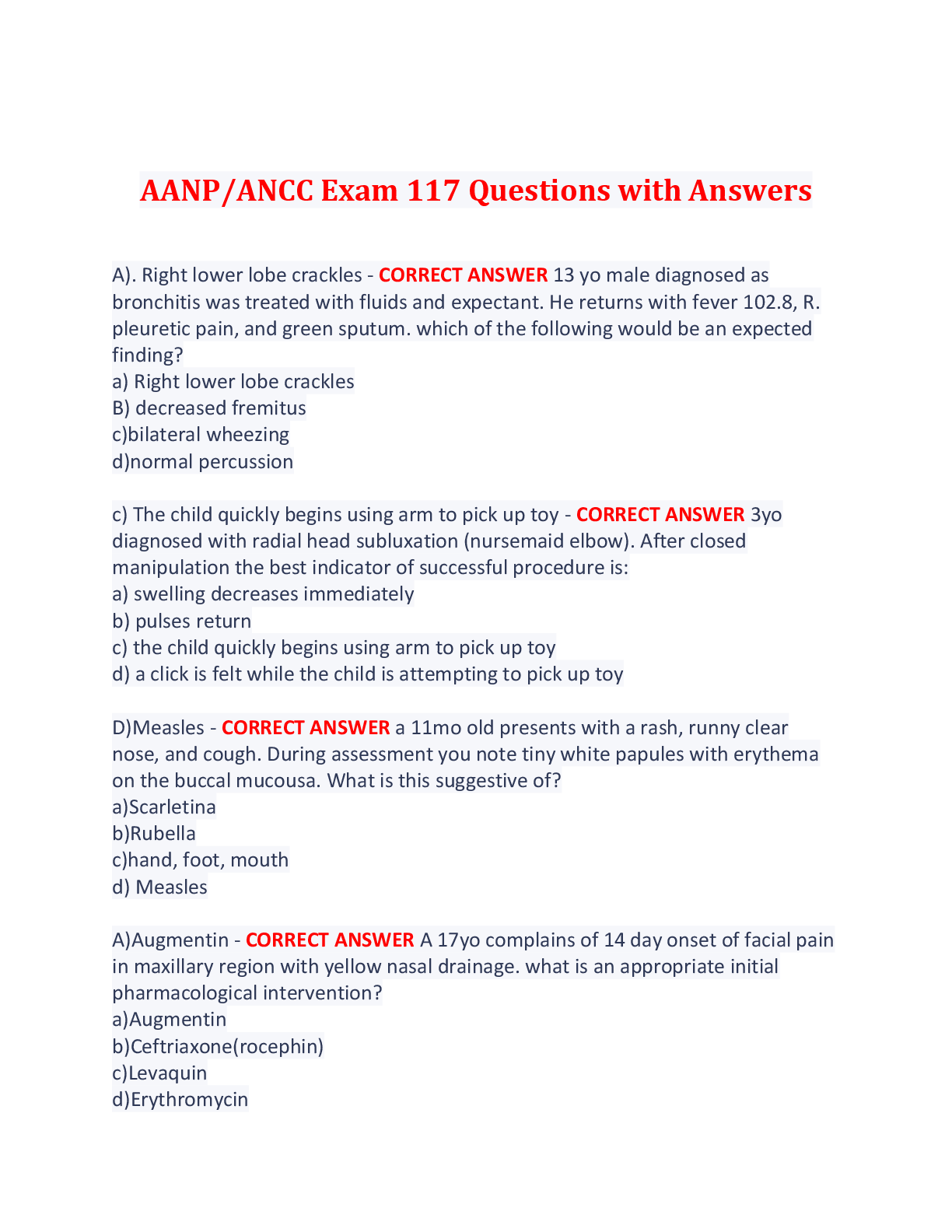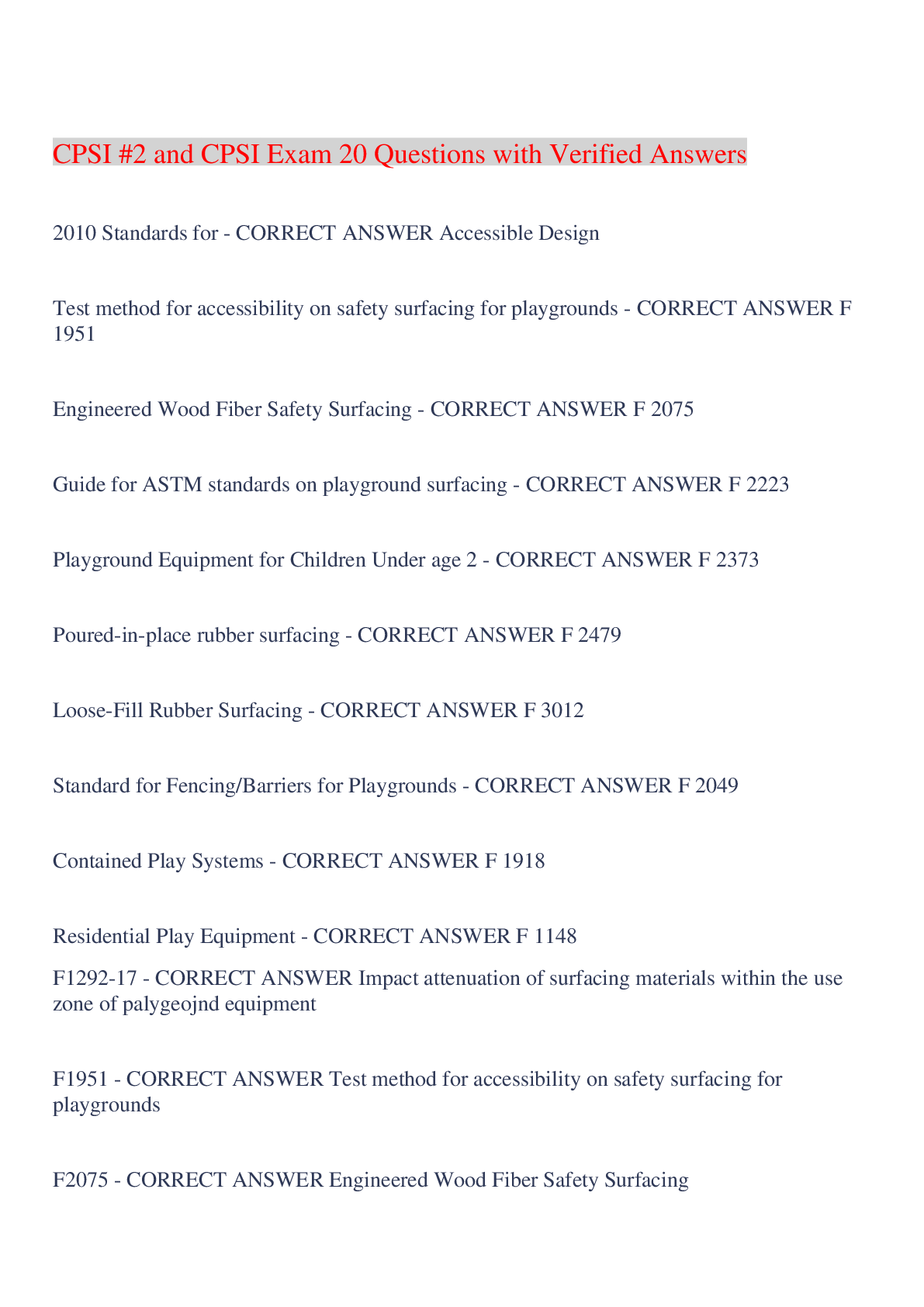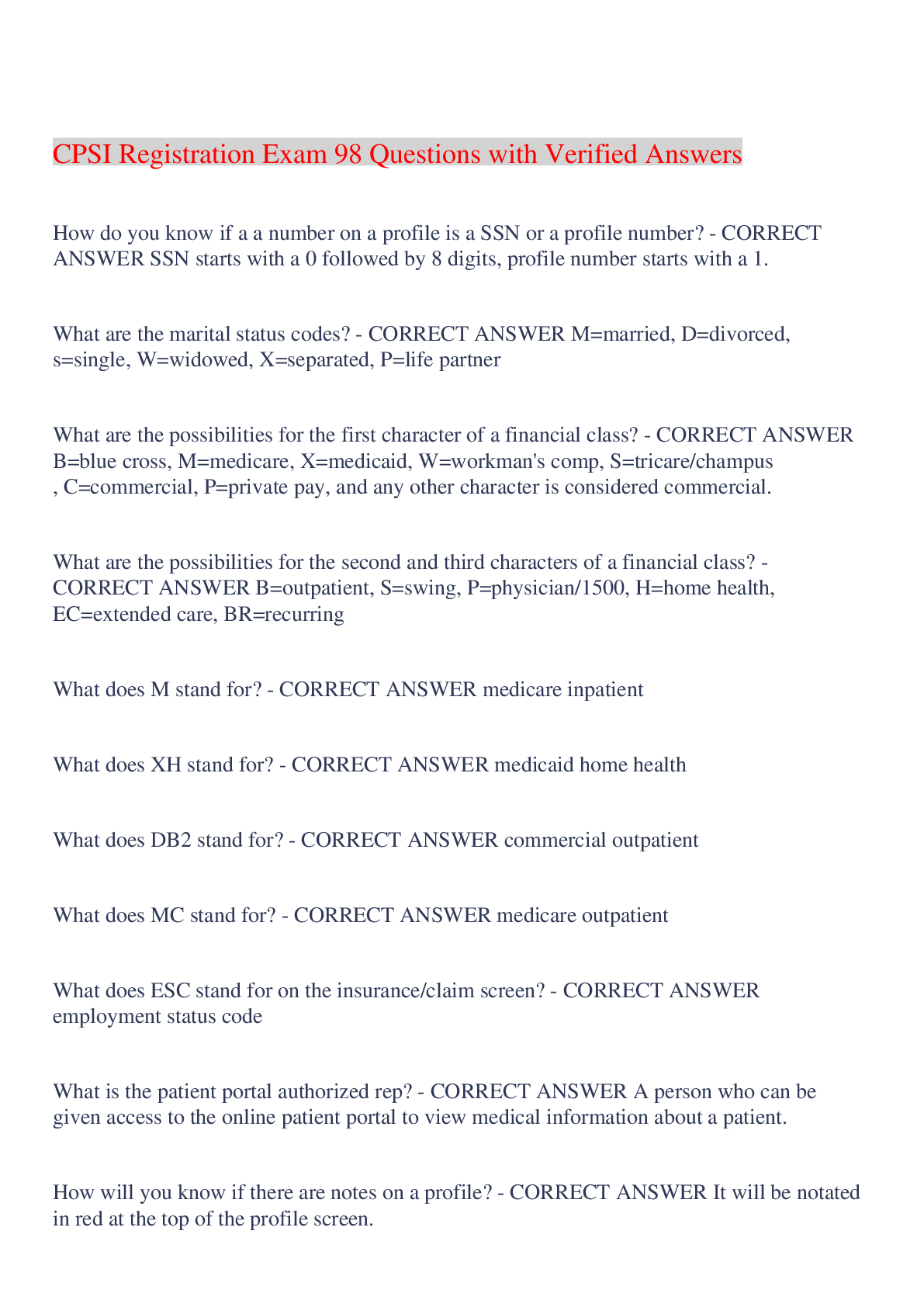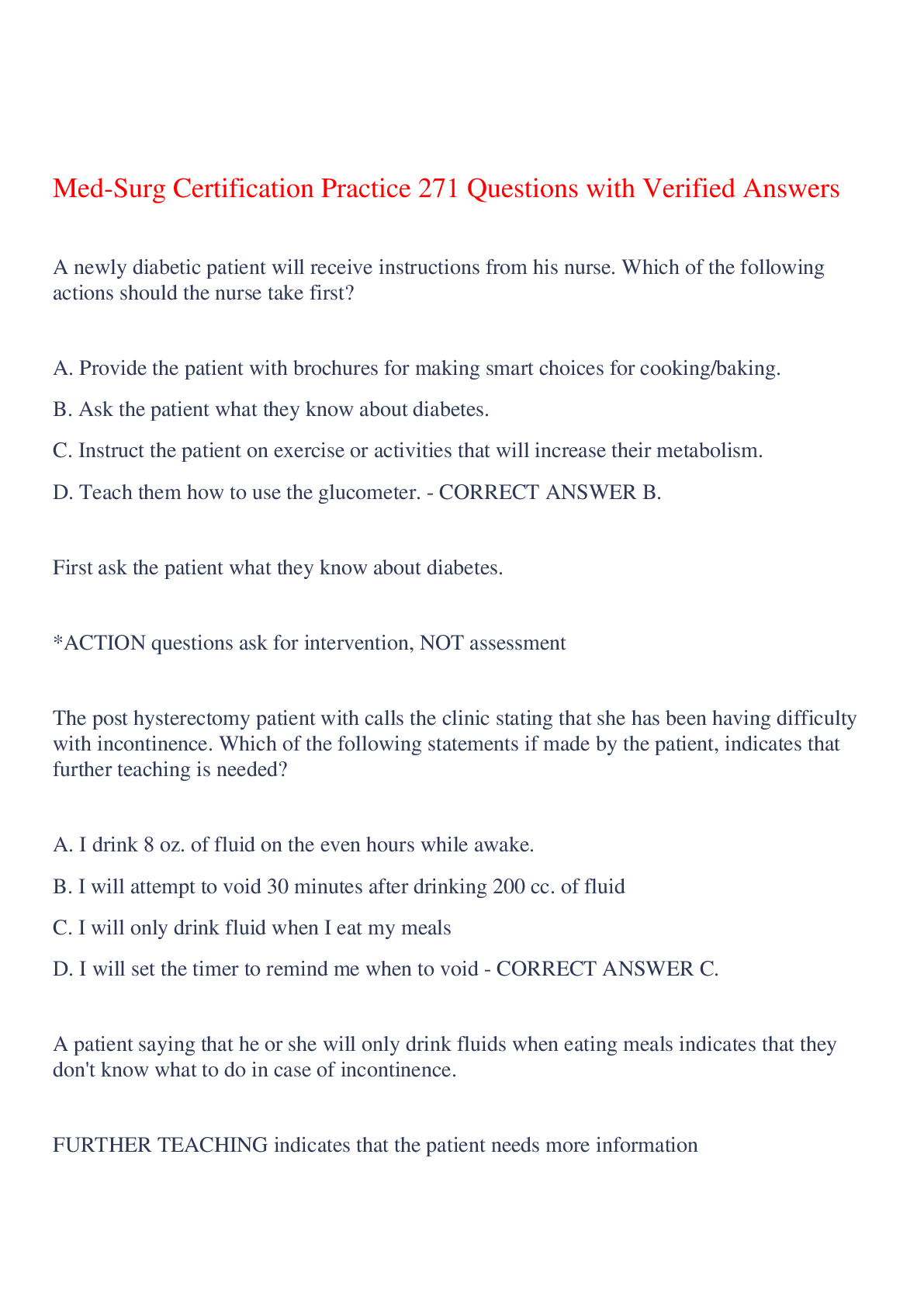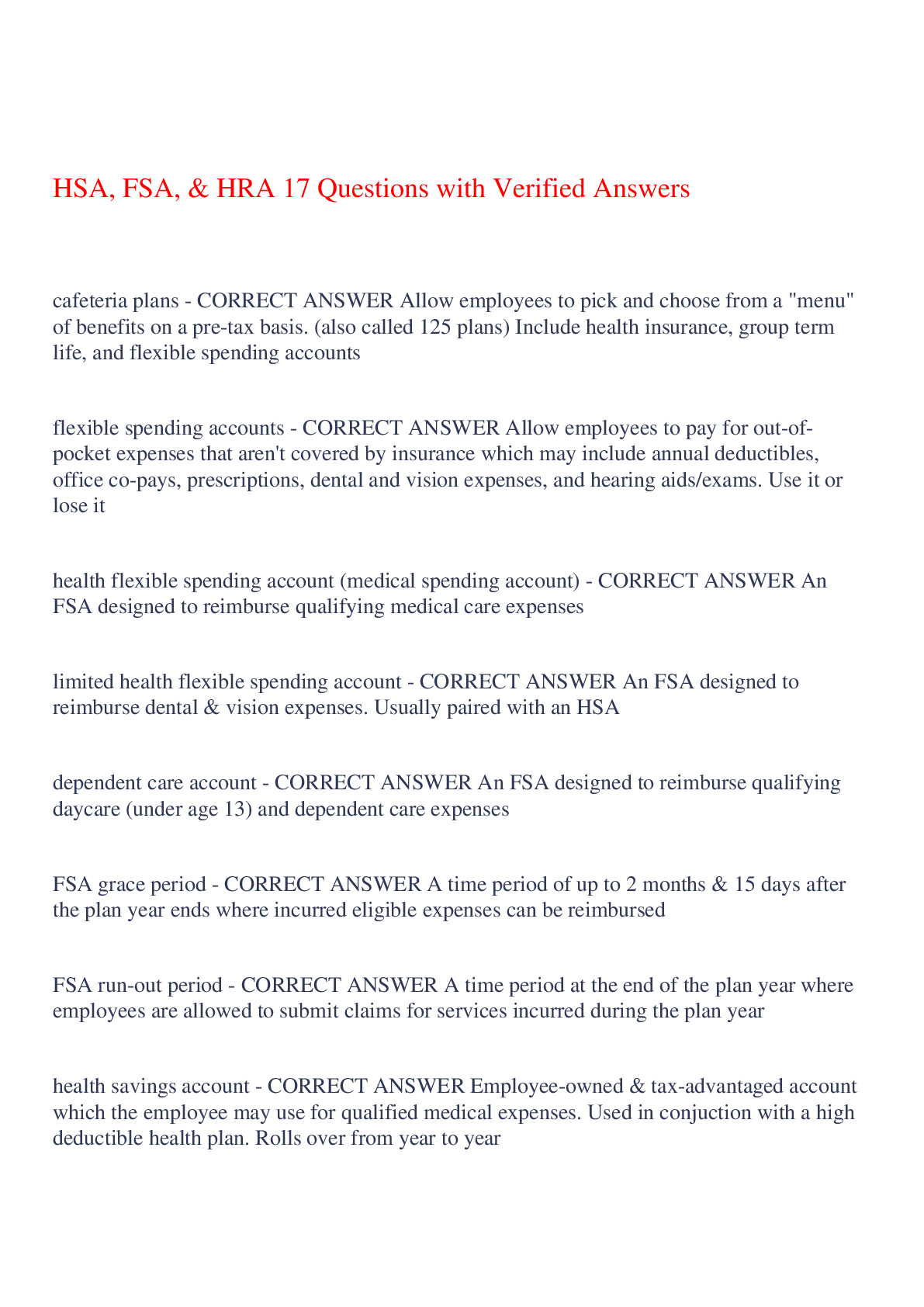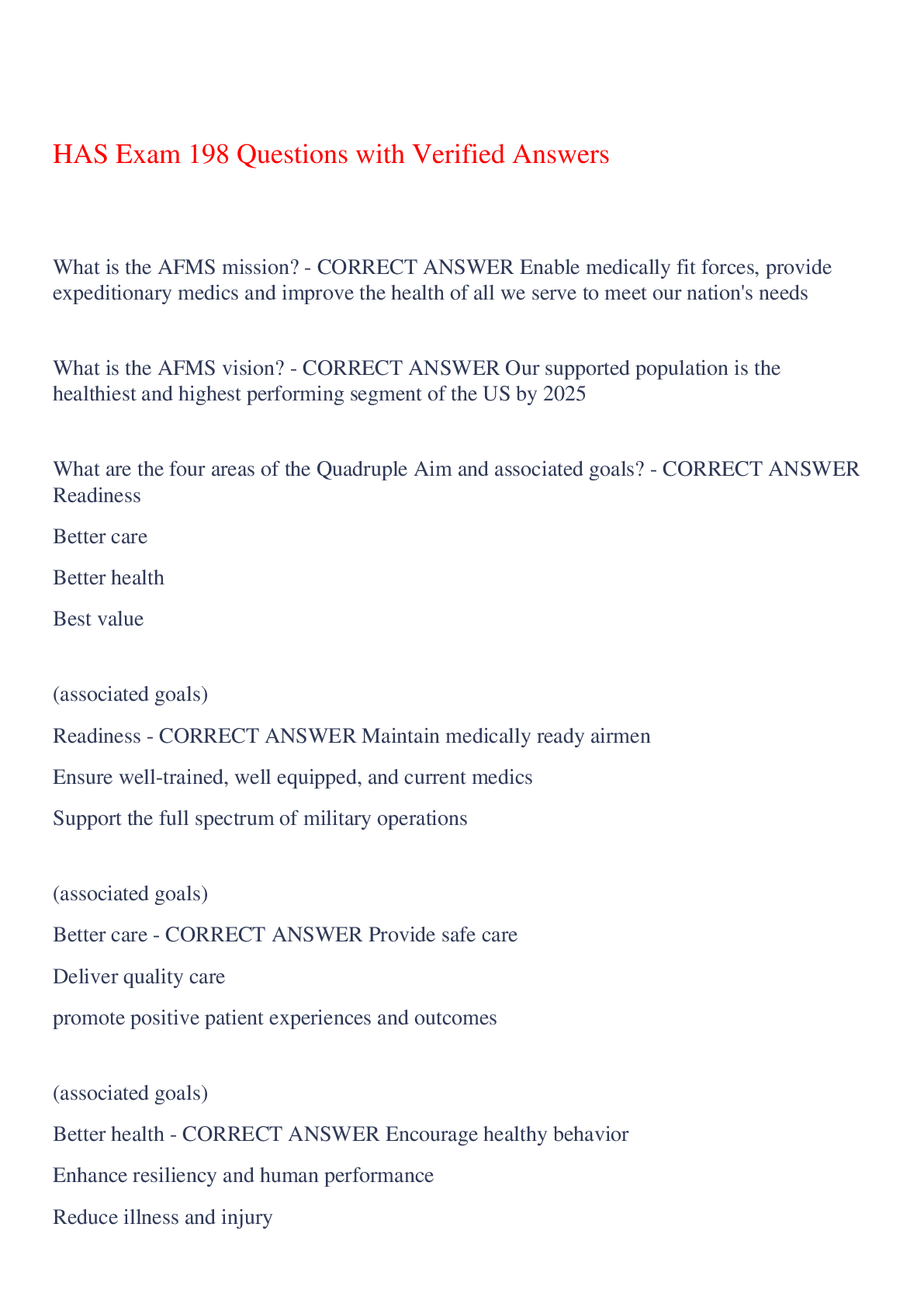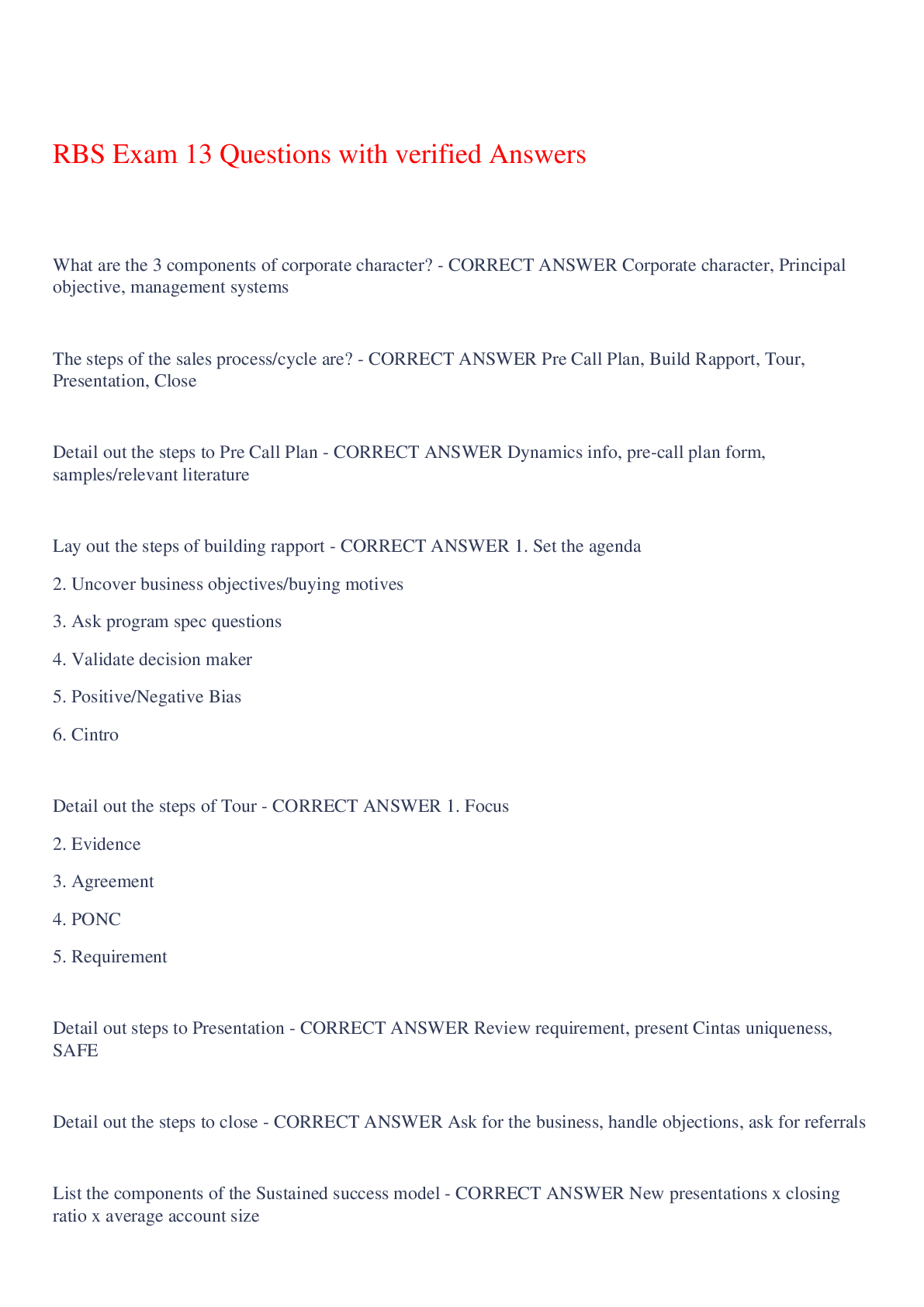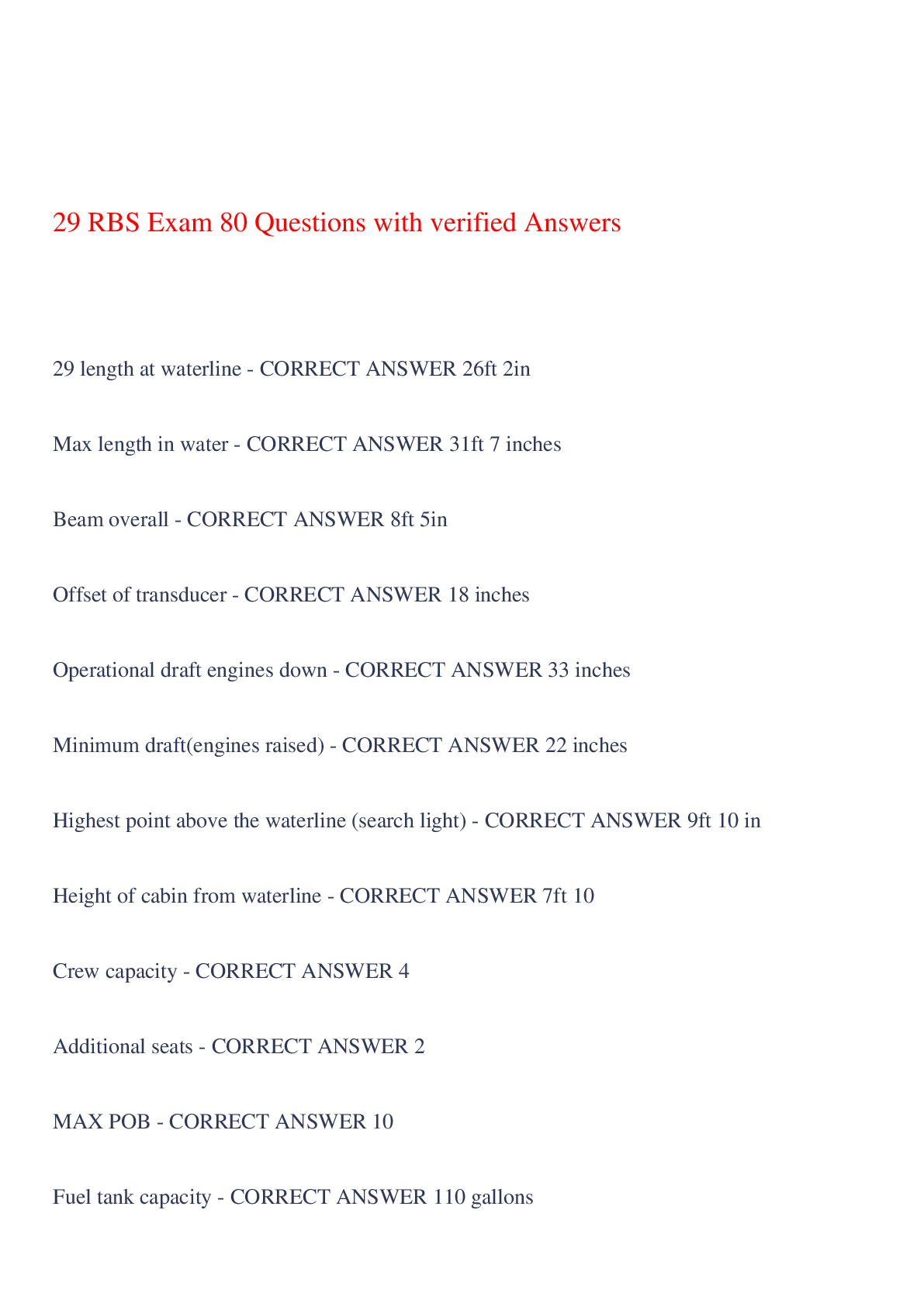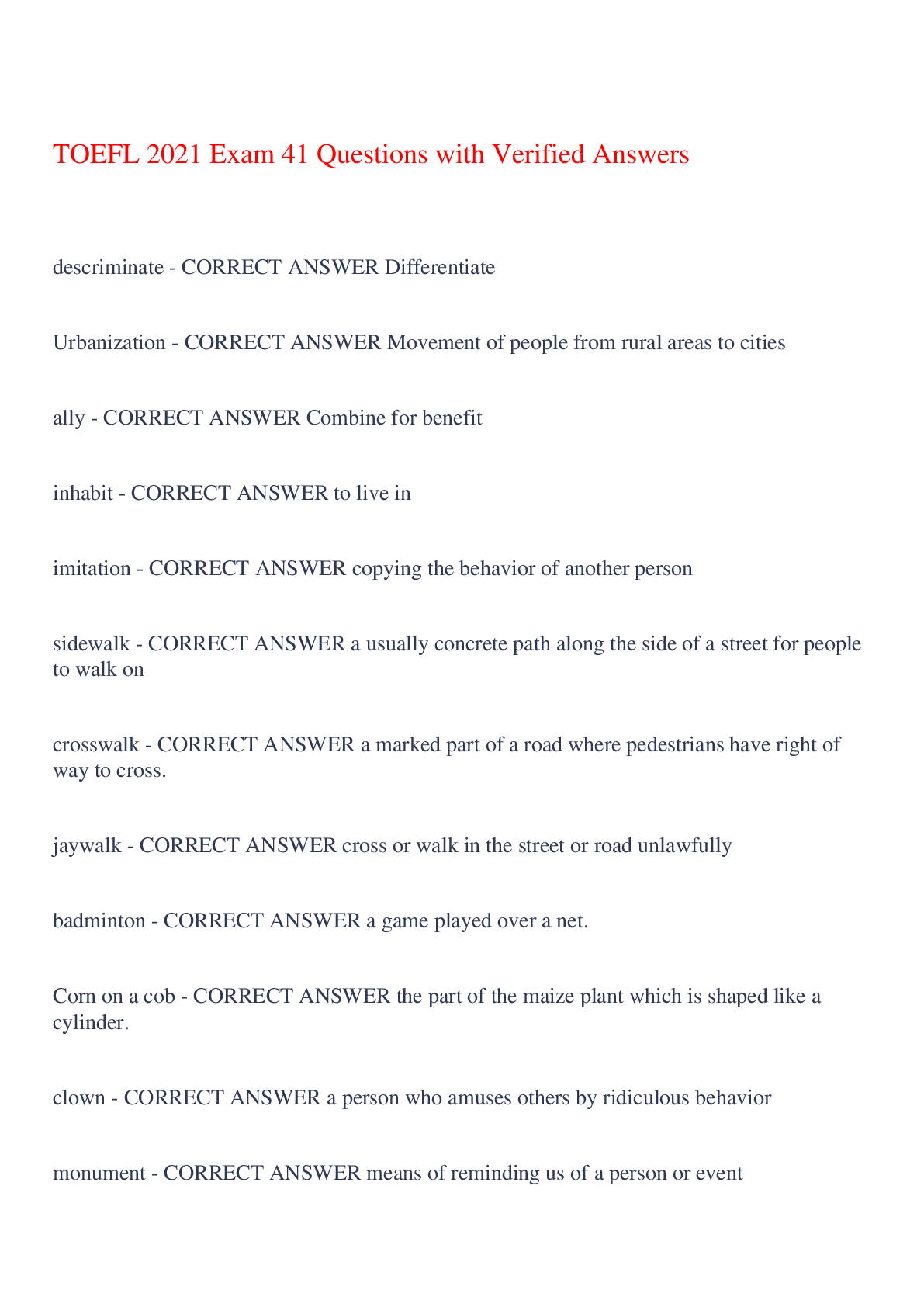CPN Practice Questions 101-150 Questions with Verified Answers,100% CORRECT
Document Content and Description Below
CPN Practice Questions 101-150 Questions with Verified Answers Hemolytic uremic syndrome (HUS) is a post-infectious disorder causing nephropathy, hemolytic anemia, and thrombocytopenia. It is seen... following upper respiratory illnesses and following GI infections after eating meat contaminated with bacteria. What enteric bacteria have been linked to HUS? A. Escherichia coli O157:H7. B. Clostridium difficile. C. Rotavirus. D. Vibrio cholera. - CORRECT ANSWER A: E. coli O157:H7 from contaminated ground meat is the most common bacterial cause of HUS although other bacteria, such as Shigella dysenteriae, may also cause HUS. Hypertension can be seen in the pediatric population. What is the most common cause of secondary hypertension in children? A. Coarctation of the aorta. B. Renal disease. C. Neuroblastomas. D. Drug toxicity. - CORRECT ANSWER B: Renal disease is the most common cause of secondary hypertension in the pediatric population. Coarctation of the aorta, neuroblastoma, and drug toxicity are less common causes of secondary hypertension. Primary hypertension is also on the rise, related to obesity, lack of exercise, and poor nutrition A 16-year-old female is brought into the ED with an intentional overdose of acetaminophen. In order to prevent liver toxicity what medication can be given? A. N-Acetylcysteine (Mucomyst). B. Activated charcoal. C. Ipecac syrup. D. Naloxone (Narcan). - CORRECT ANSWER A: N-Acetylcysteine (Mucomyst) is the medication used for acetaminophen overdoses. Toxicity occurs with dosage >140 mg/kg in one dose or >7.5g in 24 hours. The 72-hour N- acetylcysteine (NAC) protocol includes 140 mg/kg initially and 70 mg/kg every 4 hours for 17 more doses (orally or IV). Naloxone is used for opiate overdoses, and activated charcoal is used for numerous other medication overdoses. Following a severe motor vehicle accident, a 10-year-old male has a hemisection of the spinal cord with associated ipsilateral weakness and loss of proprioception and contralateral loss of pain and temperature sensation. What is this spinal cord syndrome called? A. Anterior cord syndrome B. Complete cord injury C. Brown-Sequard syndrome D. Posterior cord syndrome - CORRECT ANSWER C: Hemisection of the spinal cord, severing it on one side only, and its associated symptoms are referred to as Brown-Sequard syndrome. Anterior cord syndrome results in loss of motor abilities and some sensations (temperature, pain, vibration) below injury. Posterior cord syndrome retains motor functions but some sensation is lost below injury. Complete cord injury results in bilateral paralysis and lack of sensation below injury. A 2-year-old male inadvertently ingests some opiates from his parent's prescription medication. Which of the following would NOT be a likely physical finding? A. Decreased respiratory rate. B. Lethargy. C. Decreased bowel sounds. D. Pupillary dilation. - CORRECT ANSWER D: Pupillary constriction, not dilation, is a hallmark of opiate overdose. Decreased respiratory rate, lethargy, and decreased bowel sounds are common physical symptoms of opiate overdose. A 10-year-old child is to have a venipuncture done at the femoral site. Which of the following anatomic structures is most medial in the inguinal area? A. Femoral vein. B. Femoral artery. C. Femoral nerve. D. Anterior superior iliac crest. - CORRECT ANSWER A: The femoral vein is the most medial structure in the inguinal canal, so venipuncture should be attempted medially to where the femoral artery is palpated at the femoral triangle. An early-adolescent female is described by her mother as having no interest in participating in any activities with her parents. What aspect of psychosocial development does this reflect? A. Identity. B. Peer pressure. C. Body Image. D. Independence. - CORRECT ANSWER D: Decreased interest in parental activities is consistent with independence activities in which the adolescent begins to move away from the dependence of childhood to establish her own identity. This period is often characterized by rebellion and withdrawal from the family. A 16-year-old female presents to the clinic asking for oral contraceptive pills. Which of the following medical problems in the past would contraindicate the use of oral contraceptives? A. Migraine headaches. B. Depression. C. Deep vein thrombosis. D. Pneumonia. - CORRECT ANSWER C: A history of thromboembolic disease, such as deep vein thrombosis, is a contraindication to the use of oral contraceptive pills, as this is a side effect of the drugs. A 7-year-old male has a history of supraventricular tachycardia. His ECG shows a shortened PR interval, a delta wave, and a wide QRS pattern. What is the most likely conduction disturbance? A. Left bundle branch block (LBBB). B. Wolff-Parkinson-White syndrome (WPW). C. Right bundle branch block (RBBB). D. Mobitz type II second-degree heart block. - CORRECT ANSWER B: A shortened PR interval, delta wave, and wide QRS pattern with a history of SVT are suggestive of WPW. Atrial impulses are conducted via an anomalous pathway to the ventricles leading to a premature and prolonged depolarization of the ventricles. Ablation of the pathway is often needed. Molluscum contagiosum is a papular dome-shaped skin lesion that can occur on many parts of the body and spread by autoinoculation. What is the causative organism for this skin condition? A. Human papillomavirus. B. Poxvirus. C. Herpes virus. D. Anaerobic bacteria. - CORRECT ANSWER B: Molluscum contagiosum is caused by the poxvirus and is usually treated with debridement, liquid nitrogen, or topical salicylates. This virus often spreads from contact with someone with eczema or immunocompromised. Once infected, the lesions may persist for up to 2 years even with treatment. The prevalence of type 2 diabetes in children is rising, especially among the AfricanAmerican and Hispanic populations. What is the principle risk factor for type 2 diabetes? A. Premature birth. B. Maternal smoking. C. Obesity. D. Asthma - CORRECT ANSWER C: Childhood obesity is the primary risk factor for type 2 diabetes, and the marked recent increase in this disease corresponds with the concomitant increase in obesity. Obesity often correlates with very high carbohydrate diets and poor overall nutrition. A 15-year-old female has been diagnosed with hyperthyroidism due to Graves's disease. Which of the following symptoms would NOT likely be present in this patient? A. Bradycardia. B. Insomnia. C. Heat intolerance. D. Weight loss. - CORRECT ANSWER A: Tachycardia, not bradycardia is a common symptom of hyperthyroidism due to increase in circulating thyroid hormone levels. Insomnia, heat intolerance, and weight loss are common symptoms. Ophthalmic changes, including bulging of the eyeball, may also occur. Pediatric patients are often found to have a decreased potassium level (hypokalemia). Which of the following is NOT a common reason for hypokalemia? A. Diarrhea. B. Laxative use. C. Diabetic ketoacidosis. D. Renal failure - CORRECT ANSWER D: Renal failure causes hyperkalemia rather than hypokalemia. The hyperkalemia associated with renal failure often requires medications or dialysis. Diarrhea caused by infection or use of laxatives and diabetic ketoacidosis may result in hypokalemia. A neonate has anorexia, lethargy, vomiting, and seizures. He is thought to have an inborn error of metabolism with a high ammonia level. Which of the following is NOT an inborn error of metabolism disease? A. Argininosuccinase deficiency B. Ornithine transcarbamylase deficiency C. Cystic fibrosis D. HMG-CoA lyase deficiency - CORRECT ANSWER C: Cystic fibrosis is a disorder of chloride channels in cells and is not an inborn error of metabolism disorder, argininosuccinase deficiency, ornithine transcarbamylase deficiency, and HMG-CoA lyase deficiency are inborn errors of metabolism. Hyperammonemia is common to many diseases associated with an inborn error of metabolism. Patients with Turner's syndrome have 45 autosomal chromosomes and only one X sex chromosome. Which of the following is NOT a common component of Turner's syndrome? A. Webbed neck. B. Male sex organs. C. Short stature. D. Broad chest. - CORRECT ANSWER B: With only one X sex chromosome and no Y, all patients with Turner's syndrome are female, not male, as males die in utero. Common indications of Turner's syndrome include webbed neck, short stature, and broad chest. In addition, females often lack functioning ovaries. Which of the following common genetic syndromes involves dilation of the aortic root and possible development of aortic aneurysms? A. Trisomy 21. B. Trisomy 18. C. Fragile X. D. Marfan's syndrome. - CORRECT ANSWER D: Patients with Marfan syndrome have a disorder of connective tissue and can develop dilation of the aortic root. Marfan's syndrome is characterized by tall stature and longs limbs and digits. Patients may need treatment with beta blockers or even synthetic grafting repair if an aneurysm develops. Which lab test measures the new production of red blood cells by the body in response to any blood loss? A. Ferritin level. B. Mean corpuscular volume. C. Total iron binding capacity. D. Reticulocyte count. - CORRECT ANSWER D: The reticulocyte count is a measure of the production of new red blood cells by the body. Reticulocytes are immature red blood cells. When red blood cell production increases to offset blood loss, more reticulocytes are released into the circulation. An insufficient level may indicate a problem with the red blood cell producing elements of the body. Fresh frozen plasma (FFP) is used in the treatment of active bleeding or to reverse the effects of warfarin. Which of the following clotting factors does FFP NOT contain? A. Factor IX. B. Platelets. C. Factor V. D. Factor VII. - CORRECT ANSWER B: FFP contains all of the clotting factors (V, VII, and IX) except for platelets. FFP can be used in the treatment of disseminated intravascular coagulation (DIC) and thrombotic thrombocytopenic purpura (TTP), disorders that cause excessive bleeding. A 13-year-old male has had nasal congestion, rhinorrhea, and headaches for the past 6 months. He uses an OTC nasal spray that alleviates the symptoms but has prompt recurrence once the spray wears off. What is his likely diagnosis? A. Nonallergic rhinitis with eosinophilia syndrome (NARES). B. Rhinitis medicamentosa. C. Vasomotor rhinitis. D. Nasal polyps. - CORRECT ANSWER B: Rhinitis medicamentosa is rebound rhinitis caused from the prolonged use (usually about a week) of nasal vasoconstrictors. Discontinuation of the offending OTC medication is necessary to reduce symptoms. Many systemic diseases have skin manifestations that accompany the disorder. Erythema migrans is an annular rash with a target lesion and a clear or necrotic center. It is often accompanied by fever, headache, and myalgias. What is the systemic disease associated with erythema migrans? A. Tuberculosis. B. Syphilis. C. Lyme disease. D. HIV - CORRECT ANSWER C: Lyme disease is caused by the spirochete Borrelia burgdorferi, which is inoculated by a bite from a deer tick. About 80% of people with early Lyme disease develop erythema migrans ("bulls'-eye rash") within 1 to 30 days after infection. infectious bacteria can be classified based by their morphology as cocci, bacilli, and spirochetes. Which of the following pediatric diseases is NOT caused by a spirochete? A. Lyme disease. B. Syphilis. C. Yaws. D. Gonorrhea. - CORRECT ANSWER D: Gonorrhea is caused by a cocci bacterium. Lyme disease, syphilis, and yaws are all caused by spirochetes. Syphilis and yaws are caused by Treponema while Lyme disease is caused by the Borrelia burgdorferi spirochete. Infectious protozoa are eukaryotic organisms that can cause gastrointestinal diseases, especially in developing countries, where travelers may become infected. Which of the following organisms is a protozoan? A. Giardia lamblia. B. Salmonella typhi. C. Escherichia coli (E. coli). D. Vibrio cholera. - CORRECT ANSWER A: Giardia lamblia is a protozoan that causes infectious gastroenteritis in those who drink contaminated water or touch contaminated hands to the mouth. Salmonella typhi, E. coli, and Vibrio cholera are bacteria. Estimation of gestational age may be done in many ways. Nagele's rule is the most accurate and involves calculations using which parameter? A. Mother's last menstrual period. B. Fundal height. C. Crown-rump length (CRL) on ultrasound. D. Estimated weight on ultrasound. - CORRECT ANSWER A: Nagele's rule uses the mother's LMP and is the most accurate determination of gestational age. It is represented as estimated date of confinement (EDC) = 280 days + 7 days from LMP. What is the normal baseline fetal heart rate (FHR) in a term fetus? A. 120 to 160 bpm. B. 80 to 100 bpm. C. 100 to 120 bpm. D. 160 to 190 bpm. - CORRECT ANSWER A: The normal term FHR is 120 to 160 beats per minute. Some variation is normal but a change that persists for more than 15 minutes is significant. Mild bradycardia is 100 to 120 bpm and severe bradycardia is <90 bpm. Body mass index (BMI) is a valuable tool of measure healthy weight and a good predictor of future morbidity and mortality. It can be used to classify underweight, overweight, and obese status. What is the formula to calculate BMI using weight in kilograms and height in meters? A. Weight x height B. Height/weight C. Weight/(height) x (height) D. Height/(weight) x (weight) - CORRECT ANSWER C: BMI is calculated by weight in kilograms divided by height in meters squared. It is a useful tool in assessing weight issues. Although vitamin supplementation is occasionally needed, an overdose of fat-soluble vitamins can lead to liver toxicity. Which of the following is a water-soluble vitamin that is NOT fat-soluble? A. Vitamin A. B. Vitamin E. C. Vitamin C. D. Vitamin K. - CORRECT ANSWER C: Vitamin C is a water-soluble vitamin. Water-soluble vitamins are excreted rapidly so they do not cause toxicity although excess dosages may have some adverse effects. Vitamins A, D, E, and K are all fat-soluble and are stored in the fat for longer periods of time, so excess dosages are more likely to result in toxic reactions, such as liver toxicity. Treatment for asthma is based on guidelines related to symptom severity to determine whether medical control is adequate. If a 7-year-old female has daily daytime symptoms and symptoms more than one night per week, her asthma is in which of the following categories? A. Severe persistent. B. Moderate persistent. C. Mild persistent. D. Mild intermittent. - CORRECT ANSWER B: Asthma symptoms occurring daily and more than one night during the week are classified as moderate persistent. Treatment includes inhaled steroids with long-acting inhaled beta2-agonists. A humanistic theorist of the 20th century described a hierarchy of basic needs for all humans. His "hierarchy of needs" builds from the most basic for survival (physiologic) and ends to the most developed (self-actualization). What is the name of this philosopher? A. Carl Rogers. B. Lawrence Kohlberg. C. John Bowlby. D. Abraham Maslow. - CORRECT ANSWER D: Abraham Maslow wrote about the "hierarchy of needs" concept. Carl Rogers developed the person-centered humanistic approach to psychology. Lawrence Kohlberg described stages in moral development, and John Bowlby developed a theory of attachment. In Piaget's stages of cognitive development, the "concrete operational thinking" stage involves the child thinking in terms of absolute right and wrong without the ability to reason more complex issues. What age range does this occur in? A. Birth to 2 years B. 2 to 7 years C. 7 to 12 years D. Over 12 years - CORRECT ANSWER C: "Concrete operational thinking" stage occurs in the 7 to 12 age range when the child is able to think more logically but relies on the concrete rather than the abstract. As children become more able to understand complex issues in adolescence, they progress to the "formal operational thinking" stage. A parent is noted to be very strict with harsh discipline, high expectations, low support, and low parent-child communication. What parenting style would this be considered as? A. Authoritative parenting. B. Permissive-neglectful parenting. C. Democratic-indulgent parenting. D. Authoritarian parenting. - CORRECT ANSWER D: A strict, harsh parent with high expectations but poor communication is authoritarian. Authoritarian, permissive-neglectful, and democratiC:indulgent parenting styles are less effective than authoritative. Which permanent teeth eruption usually occurs first? A. Central incisors. B. Lateral incisors. C. Cuspids (canines). D. First premolars (Bicuspids). - CORRECT ANSWER A: The central incisors are usually the first permanent teeth to erupt around age 7 to 8, followed by the lateral incisors, the canines, the premolars (bicuspids), and finally the molars. A 10-year-old male has a repetitive and persistent dysfunctional pattern of aggressive behavior and violation of the law, social norms, and the rights of others. With which psychological disorder is this most consistent? A. Oppositional-defiant disorder. B. Conduct disorder. C. ADHD. D. Autism. - CORRECT ANSWER B: A pattern of aggressive behavior with violation of the law and social norms is typical of conduct disorder. DSM-IV-TR criteria also include aggressive behavior to people or animals, destruction of property, lying or stealing, and serious rule violations. Oppositional-defiant disorder is a pattern of behavior characterized by negative and defiant behavior towards parents, teachers, and authority figures. Which of the following would NOT be an expected clinical finding consistent with this disorder? A. Argumentative with parents. B. Defiance of rules and requests. C. Avoids activities that require focused mental attention. D. Loses temper easily - CORRECT ANSWER C: Avoidance of tasks that require mental attention and focus is a finding more consistent with ADHD than oppositional-defiant disorder, which involves defiant behavior rather than impaired mental ability. Learning disabilities refer to difficulties in various aspects of learning and a significantly lowered school performance than expected. Which of the following conditions is NOT commonly associated with learning disabilities? A. Lead poisoning. B. Cystic fibrosis. C. Fetal alcohol syndrome. D. Fragile- X syndrome. - CORRECT ANSWER B: Cystic fibrosis is not linked to any learning disabilities. Lead poisoning, fetal alcohol syndrome, and fragile-X syndrome are all common conditions associated with learning disabilities. After traumatic birth, a neonate is found to have diffuse edema of the soft tissue of the scalp, crossing suture lines. What is this finding in a neonate called? A. Macrocephaly. B. Caput succedaneum. C. Cephalohematoma. D. Microcephaly. - CORRECT ANSWER B: Edema of the scalp is caput succedaneum and usually resolves after 2 to 4 days. A cephalohematoma will not usually cross suture lines. Macrocephaly is an enlarged head, and microcephaly is a small head. A 16-year-old male is found to have a tall stature, small penis and testes, scoliosis, and decreased testosterone levels. On genetic typing, he is found to have an extra X chromosome (47XXY). What is this syndrome called? A. Trisomy 21. B. Trisomy 18. C. Turner's syndrome. D. Klinefelter's syndrome. - CORRECT ANSWER D: The 47XXY genetic typing is Klinefelter's syndrome. Turner's syndrome is 45XO. Trisomy 18 occurs with 3 copies of the 18th chromosome, causing many medical disorders. Trisomy 21 occurs with an extra 21st chromosome, resulting in intellectual disability as well as physical abnormalities. A 6-year-old uncircumcised male has a foreskin that cannot easily be retracted over the glans penis. What is the name for this urologic condition? A. Cryptorchidism. B. Hydrocele. C. Varicocele. D. Phimosis. - CORRECT ANSWER D: The inability to retract the foreskin past the glans penis after the age of 5 is called phimosis. As this can lead to painful swelling, a consultation with a urologist for potential circumcision is advised. Cryptorchidism is an undescended testis. Hydrocele occurs when an abnormality causes fluid to collect in the scrotum or along the spermatic cord. Varicocele is a varicosity in the vessels about the spermatic cord. While performing an exam on a newborn, the examiner flexes the hip and adducts the thigh and palpates a "clunk" indicating displacement of the femoral head. What is this physical exam test called? A. Ortolani's test. B. Gower's sign. C. Allis's sign. D. Barlow test. - CORRECT ANSWER D: A palpable "clunk" with a flexed, adducted hip is a positive Barlow test and indicates hip dislocation or subluxation present. Ortolani's test is also used to diagnosed congenital hip dislocation. Gower's sign assesses muscle weakness in the lower limbs and is used with Duchenne's muscular dystrophy. Allis's sign indicates fracture of the femur neck. The Mantoux skin test is used for tuberculosis screening and involves subcutaneous injection of PPD derivative in the skin and the reading of the result 48 to 72 hours later. What aspect of the skin is evaluated at this time? A. Erythema. B. Degree of pruritis. C. Induration. D. Bleeding. - CORRECT ANSWER C: The degree of induration determines a positive PPD Mantoux test. Blistering may also indicate a positive reaction in some children. An infant has microcephaly with head circumference 2 standard deviations (SD) below the mean for his age. Which of the following is NOT a common cause for microcephaly? A. Intrauterine TORCH infections. B. Hydrocephalus. C. Fetal alcohol syndrome. D. Phenylketonuria. - CORRECT ANSWER B: Hydrocephalus leads to macrocephaly in most cases while intrauterine TORCH infections, fetal alcohol syndrome, and phenylketonuria affect the development of the brain and can lead to microcephaly. An infant has strabismus with an inwardly deviated right eye (esotropia). Which eye muscle is likely to be the weak in this case? A. Lateral rectus. B. Medial rectus. C. Superior oblique. D. Inferior oblique. - CORRECT ANSWER A: The lateral rectus is weak. If the lateral rectus muscle is weak, the medial rectus is unopposed in its adduction action, resulting in esotropia. A 5 year old male has an acute illness with a vesicular exanthema on tongue, gums, and palate with fever and dysphagia. He is diagnosed with hand, foot, and mouth disease. What is the causative organism for this disease? A. Adenovirus. B. Herpes simplex virus. C. Streptococcus. D. Coxsackievirus A16. - CORRECT ANSWER D: Hand, foot and mouth disease is most commonly caused by Coxsackievirus A16. Treatment is limited to symptomatic therapy until the lesions resolve. Due to persistent asthma, a 7-year-old female is started on long-term control medications. Which of the following medications works to stabilize mast cells? A. Fluticasone (Advair). B. Budesonide (Pulmicort). C. Cromolyn (Intal). D. Theophylline (Theodur). - CORRECT ANSWER C: Cromolyn is an inhaled medication that acts by preventing mast cell from releasing their contents. It is useful in chronic asthma to reduce attacks but is not effective for the treatment of acute asthma. A newborn had a collection of small white inclusion cysts filled with cheesy material on the face, but these cysts resolved spontaneously in a few weeks. What is the most likely diagnosis? A. Milia. B. Erythema toxicum neonatorum. C. Cutis marmorata. D. Nevus Flammeus. - CORRECT ANSWER A: Milia are small raised lesions that spontaneously resolve. They are the result of keratinous material accumulated within the pilosebaceous follicle area. Erythema toxicum neonatorum is a self-limiting erythematous, blotchy macular rash on the face and torso. Cutis marmorata is the mottling of skin, common after birth. Nevus flammeus is a port-wine stain, a type of vascular birthmark. An African-American 13-year-old male has several patches of hypopigmentation on his skin surface. These have developed slowly over the past several years. What is his most likely diagnosis? A. Albinism. B. Vitiligo. C. Pityriasis rosacea. D. Pityriasis alba. - CORRECT ANSWER B: Acquired hypopigmented patches on the skin surface is consistent with vitiligo. As the spots lack melanin, they should be protected from the sun. Albinism is a genetic disorder that involves lack of pigmentation. Pityriasis rosacea is a scaly rash that appears in patches about the body. Pityriasis alba causes dry scaly pale patches on the skin, lasting a year or more. Which of the following common skin conditions is caused by a fungal infection? A. Molluscum contagiosum. B. Plantar warts. C. Tinea corporis. D. Shingles. - CORRECT ANSWER C: Tinea corporis (ringworm) is a fungal infection of the skin causing circular lesions primarily on the arms and legs. It is treated with anti-fungal topical medications. Molluscum contagiosum, plantar warts, and shingles (herpes zoster) are all caused by viruses. A 7-year-old male is treated for an anaphylactic reaction to a bee sting. What type of antibody is the prime mediator for type I hypersensitivity reactions? A. IgA. B. IgM. C. IgG. D. IgE. - CORRECT ANSWER D: Interaction of an antigen with IgE takes place on the surface of a mast cell and leads to degranulation of these cells. The substances in these granules can then lead to the overwhelming response seen in anaphylactic conditions. The most common form of viral hepatitis in children is hepatitis A. Which of the following is NOT considered a characteristic of this condition? A. Transmission by blood contact only. B. Highest rate of infection in ages 5 to 14. C. 15 to 50 day incubation. D. Commonly seen in daycare centers. - CORRECT ANSWER Hepatitis A is transmitted via a fecal/oral route, from raw shellfish and contaminated water. It is not normally transmitted via a bloodborne route as is Hepatitis B and C. Transmission often occurs in daycare centers from contamination from soiled diapers with the highest rate of infection from ages 5 to 14. The incubation period is about 15 to 50 days. A patient presents in the ED with a fever of 103 degrees F. Which of the following patients would be LEAST at risk for sepsis? A. 5-year-old with HIV. B. 8-year-old with Trisomy 21. C. 12-year-old on chemotherapy for leukemia. D. 2-week-old newborn. - CORRECT ANSWER B: A child with Trisomy 21 would not normally have a decreased immune system and would not have an increased risk for sepsis. Both the child with HIV and the one receiving chemotherapy are immunocompromised, increasing risk. The 2-week child's immune system is still immature, putting the child at risk. A 4-year-old child is found to have a lateral bowing of the tibia that does not increase after walking. What is this condition known as? A. Metatarsus adductus. B. Metatarsus varus. C. Genu varum. D. Genu valgum. - CORRECT ANSWER C: Genu varum refers to bowing of the legs. Genu valgum is the abnormal closeness between the knees (knock-knees). Metatarsus varus and adductus refer to forefoot conditions. [Show More]
Last updated: 1 year ago
Preview 1 out of 17 pages
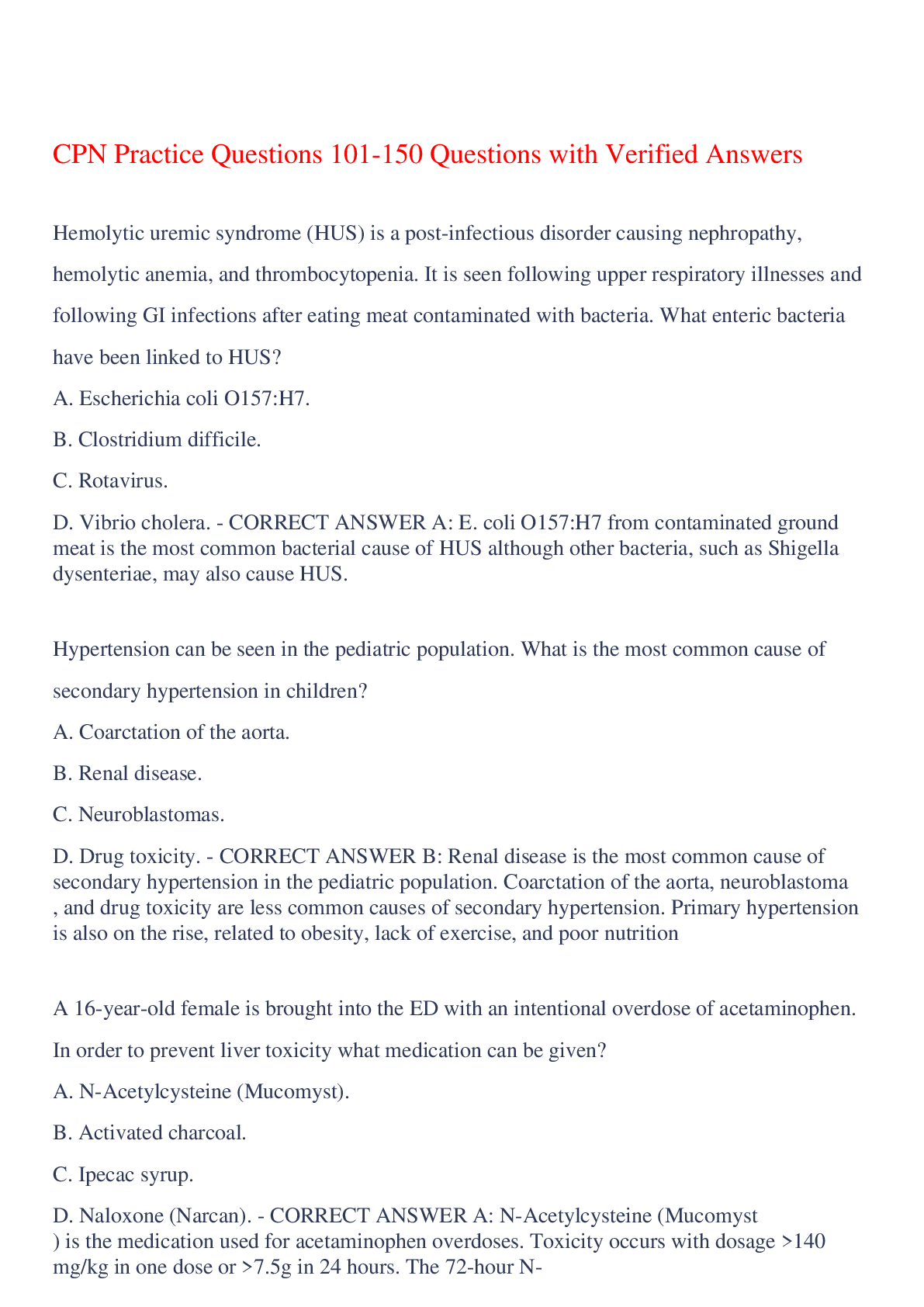
Buy this document to get the full access instantly
Instant Download Access after purchase
Buy NowInstant download
We Accept:

Reviews( 0 )
$9.50
Can't find what you want? Try our AI powered Search
Document information
Connected school, study & course
About the document
Uploaded On
Nov 08, 2023
Number of pages
17
Written in
Additional information
This document has been written for:
Uploaded
Nov 08, 2023
Downloads
0
Views
131


